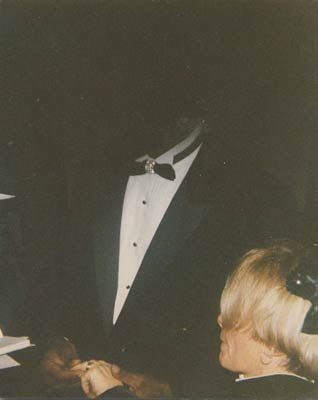relationships
Can you imagine getting off a roller coaster ride and falling in love with the first attractive person you see as you leave the ride? Likely not.
But in fact, classic social psychology experiments have shown that sometimes people do misattribute feelings of fear and anxiety to sexual attraction.
More generally, researchers have found that when people feel physiologically aroused (think racing heart, sweaty palms), they use environmental cues to help them determine why they are feeling that way.
{ Psych Your Mind | Continue reading }
psychology, relationships | May 31st, 2011 7:58 pm
birds, relationships, video | May 31st, 2011 2:33 pm

The number of people we can truly be friends with is constant, regardless of social networking services like Twitter, according to a new study of the network.
Back in early 90s, the British anthropologist Robin Dunbar began studying the social groups of various kinds of primates. Before long, he noticed something odd.
Primates tend to maintain social contact with a limited number of individuals within their group. But here’s the thing: primates with bigger brains tended to have a bigger circle of friends. Dunbar reasoned that this was because the number of individuals a primate could track was limited by brain volume.
Then he did something interesting. He plotted brain size against number of contacts and extrapolated to see how many friends a human ought to be able to handle. The number turned out to be about 150.
Since then, various studies have actually measured the number of people an individual can maintain regular contact with. These all show that Dunbar was just about spot on (although there is a fair spread in the results).
What’s more, this number appears to have been constant throughout human history–from the size of neolithic villages to military units to 20th century contact books.
But in the last decade or so, social networking technology has had a profound influence on the way people connect. Twitter, for example, vastly increases the ease with which we can communicate with and follow others. It’s not uncommon for tweeters to follow and be followed by thousands of others.
So it’s easy to imagine that social networking technology finally allows humans to surpass the Dunbar number. Not so say Bruno Goncalves and buddies at Indiana University.
{ The Physics arXiv Blog | Continue reading }
related { What Do People Actually Tweet About? }
photo { Isaac McKay-Randozz }
neurosciences, relationships, social networks | May 30th, 2011 6:18 pm

Let me toss out the idea that, as our markets discover and respond to what consumers most want, our technology has become extremely adept at creating products that correspond to our fantasy ideal of an erotic relationship, in which the beloved object asks for nothing and gives everything, instantly, and makes us feel all powerful, and doesn’t throw terrible scenes when it’s replaced by an even sexier object and is consigned to a drawer.
{ NY Times | Continue reading }
ideas, relationships, technology | May 30th, 2011 12:45 am

The amazement that can turn out to have been the beginning of love usually leads nowhere but still alerts one to the value at which full-blown love would stand in amazement. Lucky for me, my wife sometimes strikes me afresh with wonder, as if I hadn’t already known her for forty years: she strikes me, then, as if she were a wonderful stranger. If I weren’t vulnerable to strangers, I would be lacking in vulnerability to that occasional stranger who is my wife.
Feeling incipient love for a perfect stranger thus enlivens one’s capacity for appreciating personhood in other ways. It may be followed by reflective solitude or depressing loneliness or the thought of a real-life lover, all of which are further ways of valuing personhood.
{ J. David Velleman, Sociality and Solitude | Continue reading }
ideas, relationships | May 23rd, 2011 6:23 pm

A meta-analysis finds gender differences in sexual attitudes and behaviors are smaller than you may think. (…)
Synthesizing the results of more than 700 studies, psychologists Jennifer Petersen and Janet Shibley Hyde of the University of Wisconsin-Madison report “men and women are more similar than they are different in terms of sexuality.” They found only small differences between males and females in 22 of 30 common sexual behaviors and attitudes — and no differences at all for another four.
The sexual behaviors surveyed included frequency of intercourse, number of partners, extramarital sex and condom use. A separate list examined sexual attitudes, including permissiveness, anxiety and guilt, satisfaction with one’s sex life and views regarding homosexuality.
The researchers found substantial gender differences in two categories: reported masturbation and pornography use. (…)
Overall, the report provides at least qualified support for several theoretical models — including evolutionary psychology, which contends that men have evolved to desire multiple sex partners because it increases their odds of passing their genes down to the next generation. (Women, on the other hand, “have evolved to disapprove of casual sex because it may yield fathers who do not provide for them and their children.”) The fact that men reported more permissive sexual attitudes and engaged in more sexual behavior is consistent with this notion.
{ Miller-McCune | Continue reading }
related { Women who are sexually satisfied are also happier, no matter their age, a study suggests }
genders, relationships, sex-oriented | May 16th, 2011 7:35 pm

Do groups have genetic structures? If so, can they be modified?
Those are two central questions for Thomas Malone, a professor of management and an expert in organizational structure and group intelligence at MIT’s Sloan School of Management. (…)
First is the question of whether general cognitive ability — what we think of, when it comes to individuals, as “intelligence” — actually exists for groups. (…)
And what they found is telling. “The average intelligence of the people in the group and the maximum intelligence of the people in the group doesn’t predict group intelligence,” Malone said. Which is to say: “Just getting a lot of smart people in a group does not necessarily make a smart group.” Furthermore, the researchers found, group intelligence is also only moderately correlated with qualities you’d think would be pretty crucial when it comes to group dynamics — things like group cohesion, satisfaction, “psychological safety,” and motivation. It’s not just that a happy group or a close-knit group or an enthusiastic group doesn’t necessarily equal a smart group; it’s also that those psychological elements have only some effect on groups’ ability to solve problems together.
So how do you engineer groups that can problem-solve effectively? First of all, seed them with, basically, caring people. Group intelligence is correlated, Malone and his colleagues found, with the average social sensitivity — the openness, and receptiveness, to others — of a group’s constituents. The emotional intelligence of group members, in other words, serves the cognitive intelligence of the group overall.
{ Nieman Journalism Lab | Continue reading }
photo { Richard Avedon }
psychology, relationships, science | May 7th, 2011 10:08 am

A psychology study from Hong Kong suggests that, among men, the impulses to make love and war are deeply intertwined.
In a 2002 book, Chris Hedges compellingly argued that war is both an addiction and a way of engaging in the sort of heroic struggle that gives our lives meaning.
Evolutionary psychologists, on the other hand, see war as an extension of mating-related male aggression. They argue men compete for status and resources in an attempt to attract women and produce offspring, thereby passing on their genes to another generation. This competition takes many forms, including violence and aggression against other males — an impulse frowned upon by modern society but one that can be channeled into acceptability when one joins the military.
It’s an interesting and well-thought-out theory, but there’s not a lot of direct evidence to back it up. That’s what makes “The Face That Launched a Thousand Ships,” a paper just published in the journal Personality and Social Psychology Bulletin, so intriguing.
A team of Hong Kong-based researchers led by psychologist Lei Chang of Chinese University conducted four experiments that suggest a link between the motivation to mate and a man’s interest in, or support for, war.
{ Miller-McCune | Continue reading }
relationships, science | May 3rd, 2011 3:50 pm

In a relationship, who do you think is more likely to say “I love you” first – men or women?
In a recent study, 64% of participants were likely to think women were the first to say they were in love, and these professions were estimated to occur close to 2 months into a relationship. The stereotype is that women are more interested in relationships, especially serious relationships, and are therefore more likely to confess their feelings sooner than men.
When looking at actual relationships, however, men were more likely to profess their feelings first. 62% of participants reporting on past relationships and 70% reporting on current relationships stated that the man said “I love you” first. On average, men started thinking about professing their love about 3 months into the relationship whereas women in the study started thinking about it closer to 5 months into the relationship.
{ eHarmony | Continue reading }
photo { Eric Antoine }
relationships | April 29th, 2011 4:41 pm

Because the concept of love can mean different things across different types of relationships (e.g. friends, children, romantic relationships), researchers have worked at developing models that allow differentiation between varying experiences of love.
This study identifies the key factors underlying the most popular measures of love in use today through meta-analytic factor analysis. Findings reveal that general love, romantic obsession, and practical friendship are important measures in romantic relationships. Love was positively and obsession was negatively associated with relationship satisfaction and length.
{ SAGE | Continue reading }
psychology, relationships | April 27th, 2011 8:18 pm
relationships, sex-oriented | April 21st, 2011 6:55 pm

By asking a group of older adults to analyze videos of other people conversing — some talking truthfully, some insincerely — a group of scientists at the University of California, San Francisco has determined which areas of the brain govern a person’s ability to detect sarcasm and lies.
Some of the adults in the group were healthy, but many of the test subjects had neurodegenerative diseases that cause certain parts of the brain to deteriorate. The UCSF team mapped their brains using magnetic resonance imaging, MRI, which showed associations between the deteriorations of particular parts of the brain and the inability to detect insincere speech.
{ UCSF | Continue reading }
brain, relationships | April 18th, 2011 3:56 pm

You know how when you’re in an elevator or an underground train, everybody seems to try their darnedest not to look anyone else in the eye. This everyday experience completely contradicts hundreds of psychology studies conducted in the lab, which show how rapidly our attention is drawn to other people’s faces and especially their eyes.
Why the contradiction? Because psychologists have used pared down, highly controlled situations to study where people look, often involving faces and social scenes presented on a computer screen. And crucially, when participants look at a monitor, they generally know that the other person can’t look back. (…)
“Through the simple act of introducing the potential for social interaction, visual behaviour changed dramatically,” the researchers said.
{ BPS | Continue reading }
psychology, relationships | April 18th, 2011 3:20 pm

Anecdotal reports suggest that some users of ecstasy (MDMA) experience increased feelings of empathy and are more social while under influence of the drug. Such effects may contribute to the timing and frequency of ecstasy use and may also contribute to risk of abuse or dependence. Understanding this phenomenon in more detail might provide clinicians with better strategies to reduce use and the associated complications of ecstasy use.
Studying acute effects of illicit drugs is difficult under natural conditions. Users of ecstasy commonly also use alcohol, nictoine and other illicit drugs in the context of ecstasy use. Isolating psychological effects of one agent in this type of environment is difficult if not impossible. One alternative is to admiinster ecstasy in a laboratory setting with subjects blind to whether ecstasy or placebo is being administered. However, this approach poses significant ethical challenges. One approach, is to limit human study in the lab to those who have previously use ecstasy and intend to continue using. (…)
A study in Biological Psychiatry took this approach when over four sessions, healthy ecstasy using volunteers received either a low or high dose of MDMA, a dose of methamphetamine (METH) or placebo. (…)
Findings suggest MDMA increases social approach (sociability). The study supports the possibility that increased social behavior with MDMA might be due to a reduced sensitivity to negative emotions of others rather than increasing recognition of positive emotions in others.
{ Brain Posts | Continue reading }
photo { Noritoshi Hirakawa }
drugs, neurosciences, photogs, relationships | April 13th, 2011 2:57 pm

During the late Victorian period British women maintained a significant numerical advantage over men such that “almost one in three of all adult women were single and one in four would never marry.” Therefore it is no coincidence that spinsters “provided the backbone” of the women’s suffrage movement in the late nineteenth and early twentieth century. These spinster-led feminists opposed patriarchal exploitation and challenged “the idea that male sexuality was a powerful and uncontrollable urge,” and in the course of their activism drew much needed attention to other related problems such as prostitution and the abuse of girls. But by presenting such resistance to the status quo their rising success roused an equally powerful countervailing enemy whose rise to power was intimately connected to the proponents of the “sexual revolution” that came to fruition in the 1920s.
{ Swans| Continue reading }
flashback, ideas, relationships | March 31st, 2011 6:37 pm
relationships | March 30th, 2011 7:30 pm

One of the mysteries of human behavior is why we sometimes act with completely selfless altruism. When asked to play totally anonymous games in which we can cheat without anyone else ever finding out, very often we don’t.
Instead, we play the game fairly, which results in a cost to ourselves (compared with what we could’ve had) and a benefit to the stranger. That’s a mystery because evolution says that organisms which don’t act to maximize benefit to themselves - whatever the cost to others - should die out.
Several explanations have been put forward, but one of the most intriguing stems from the fact that we live in social networks. In a network like this, we depend critically on the kindness of others.
A new study has looked at how altruistic behavior can be transmitted between players in the kinds of anonymous games that social psychologists are so fond of.
What they found was that the amount individuals contributed in one round was affected by how generous their partners were in previous rounds. If they played with generous people in round 1, then they would be more generous to the new partners they had in round 2. In fact, they showed that this effect was propagated through new partners.
Unselfish acts propagated out to 3 degrees of separation. When you remember that only 6 degrees of separation stand between you and every other person on the planet, you can understand how powerful and important this effect is.
{ Epiphenom | Continue reading }
Most people with an interest in evolution understand why selfish genes do not mean selfish individuals. It’s clear that selfish genes will benefit from co-operation (you scratch my back and I’ll scratch yours, also known as reciprocity), and kin selection (as the biologist JBS Haldane famously put it, “I would lay down my life for two brothers or eight cousins”).
What most people may not know (I certainly didn’t before reading West’s article) is that these, in fact, are the sole genetic basis for altruism. But if that’s the case, how do you get from here to the apparently completely selfless altruism sometimes seen in humans?
Reciprocity doesn’t need to be direct to be effective. If, by sharing with you I help to set up a virtuous circle, that will likely result in some benefit to me down the line. This has been seen in practice, with virtuous deeds propagating out to at least three degrees of separation.
{ Epiphenom | Continue reading }
photo { Noah Kalina }
psychology, relationships | March 30th, 2011 7:00 pm

How well do you know your friends? (…)
There are lots of ways to know someone’s personality. You can say “she’s an extrovert” or “she’s usually happy.” You may also know how he or she reacts to different situations and other people’s behavior. “It’s a more detailed way of understanding personality,” says Charity A. Friesen, a graduate student at Wilfrid Laurier University, who co-wrote a new paper with Lara K. Kammrath.
“You might know the person is extroverted when they’re out with their friends but more introverted when they’re in a new situation.” When a person is faced with one of a list of situations, then how does he or she behave? Friesen identifies this as an “if-then profile.” (…)
Some people knew their friends’ triggers well; others had almost no idea what set their friends off. And that made a difference to the friendship. People who had more knowledge of their friend’s if-then profile of triggers had better relationships. They had less conflict with the friend and less frustration with the relationship.
{ APS | Continue reading }
psychology, relationships | March 25th, 2011 7:26 pm

Despite wide acceptance of the stereotype that women apologize more readily than men, there is little systematic evidence to support this stereotype or its supposed bases (e.g., men’s fragile egos). We designed two studies to examine whether gender differences in apology behavior exist and, if so, why. (…)
Findings suggest that men apologize less frequently than women because they have a higher threshold for what constitutes offensive behavior.
{ Psychological Science/SAGE | Continue reading }
psychology, relationships | March 23rd, 2011 5:06 pm




















